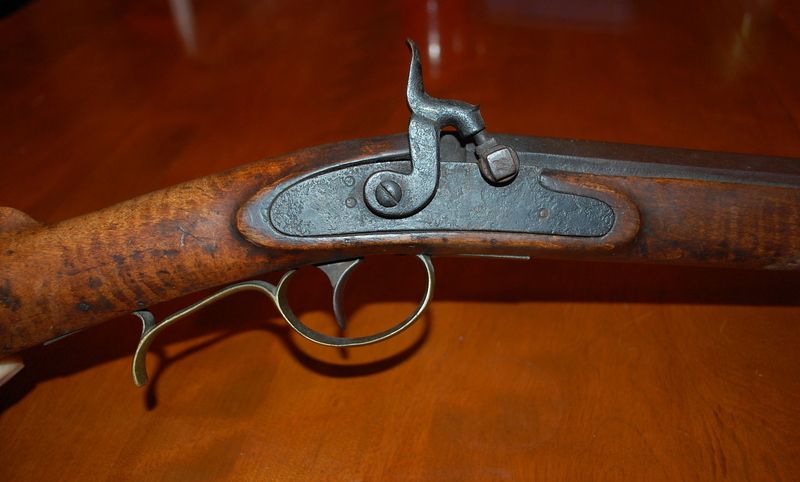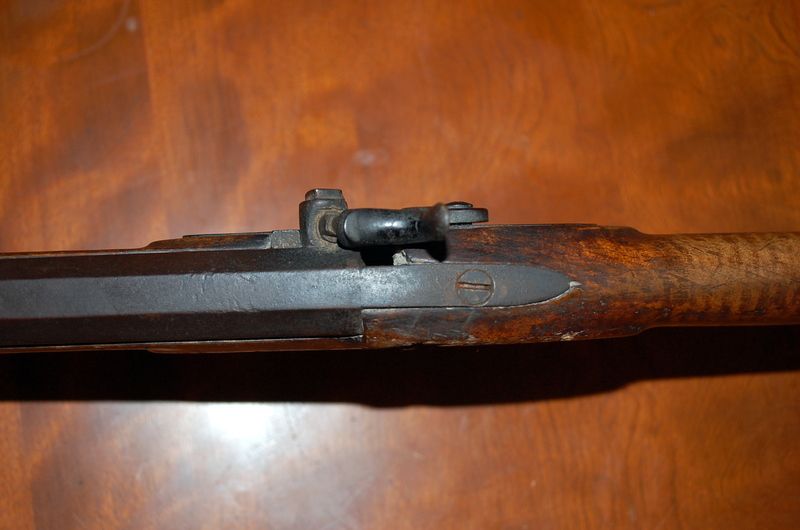I have what looks to be an original Leman smooth rifle and I noticed that the drum is very far back on the breech to the point where it would have to intersect the plug. I know CVA did this on their rifles, but I am curious how often it was done by Leman and other builders. At some point I would like to build a Leman rifle, but I am wondering what procedure to use. One thought was to cup the face of the breech plug and drill the powder drum to intersect, though with a 15/16 barrel and 3/4 plug that doesn't leave much meat unless you really go into the plug. The only other option would seem to turn a solid patent breech and than place the drum where it would be historically correct. What are your thoughts?
-
This community needs YOUR help today. We rely 100% on Supporting Memberships to fund our efforts. With the ever increasing fees of everything, we need help. We need more Supporting Members, today. Please invest back into this community. I will ship a few decals too in addition to all the account perks you get.

Sign up here: https://www.muzzleloadingforum.com/account/upgrades -
Friends, our 2nd Amendment rights are always under attack and the NRA has been a constant for decades in helping fight that fight.
We have partnered with the NRA to offer you a discount on membership and Muzzleloading Forum gets a small percentage too of each membership, so you are supporting both the NRA and us.
Use this link to sign up please; https://membership.nra.org/recruiters/join/XR045103
You are using an out of date browser. It may not display this or other websites correctly.
You should upgrade or use an alternative browser.
You should upgrade or use an alternative browser.
Is it safe to intersect breech plug with drum?
- Thread starter 44-henry
- Start date

Help Support Muzzleloading Forum:
This site may earn a commission from merchant affiliate
links, including eBay, Amazon, and others.
varsity07840
45 Cal.
- Joined
- Jun 5, 2003
- Messages
- 910
- Reaction score
- 3
I have original rifle with a massive 1 3/8" barrel
that has the drum threaded into the plug, although
for whatever reason the length of the plug is rather long. I think in the case of your rifle, the location of the drum is an exception rather than the norm. Perhaps it's the result of some alteration to the barrel at the breech end. I don't think that you should consider it to be a historically correct location for your build. Actually, if you're going to use a stock and components from TOW or similar suppliers, you'll
have to locate the drum further forword than on your rifle. Take a look at the percussion Leman on TOW's site as an example.
that has the drum threaded into the plug, although
for whatever reason the length of the plug is rather long. I think in the case of your rifle, the location of the drum is an exception rather than the norm. Perhaps it's the result of some alteration to the barrel at the breech end. I don't think that you should consider it to be a historically correct location for your build. Actually, if you're going to use a stock and components from TOW or similar suppliers, you'll
have to locate the drum further forword than on your rifle. Take a look at the percussion Leman on TOW's site as an example.
The breech on this gun does not appear to have been shortened, altered in anyway and it appears from other pictures I have found that a lot of other rifles that I have the drum quite far back as well. I am wondering if the TOW version went with a more modern interpretation of lock placement when they created their plans.
You can see in the photo below how close to the breech the drum is:

View from the top

You can see in the photo below how close to the breech the drum is:

View from the top

I haven't taken the barrel out of the stock, but you can see the lug through the lock mortise and everything looks like you would expect. I have seen a few other Leman arms that have the drum this far back so it must have been a fairly common practice. CVA shows similar arrangements with the drum intersecting the plug and the breech was than line bored to create the powder chamber. Probably a strong arrangement, but difficult to remove the plug and keep the register.
I think if I go ahead and build one I will make a patent breech and thread the drum into that. It probably isn't authentic, but I don't think it will be noticeable under the browning finish and it will allow me to keep the architecture the same as the original. I dislike precarved stocks so I will be building from a blank anyway, so no problems there.
I think if I go ahead and build one I will make a patent breech and thread the drum into that. It probably isn't authentic, but I don't think it will be noticeable under the browning finish and it will allow me to keep the architecture the same as the original. I dislike precarved stocks so I will be building from a blank anyway, so no problems there.
Nock breeches didn't have much meat behind them.
https://www.trackofthewolf.com/Categories/PartDetail.aspx/327/1/PLAN-NOCK
Last edited by a moderator:
I have pulled the breech plugs off of quite a few old original muzzle loading rifles over the years.
Quite a few of them had there drums or touch holes bored into the face of the plug.
It is actually a "standard procedure" to first remove the drum or touch hole liner before attempting to remove the breech plug. This is for obvious reasons.
If you ever care to study the original guns you will find that the majority of the flintlock arms have the lock fence behind the priming pan lined up with the end of the barrel. That is the line where the barrel meets the breech plug tang, or very very close to it.
When these rifles were later converted to percussion the same line up was used most often. Sometimes the barrels were cut at the breech end, but the drums still had to line up with the lock.
Quite a few of them had there drums or touch holes bored into the face of the plug.
It is actually a "standard procedure" to first remove the drum or touch hole liner before attempting to remove the breech plug. This is for obvious reasons.
If you ever care to study the original guns you will find that the majority of the flintlock arms have the lock fence behind the priming pan lined up with the end of the barrel. That is the line where the barrel meets the breech plug tang, or very very close to it.
When these rifles were later converted to percussion the same line up was used most often. Sometimes the barrels were cut at the breech end, but the drums still had to line up with the lock.
Pete G
76 Cal.
If you are going with a patent breech take a look at
https://www.trackofthewolf.com/Categories/PartDetail.aspx/666/1/PLUG-OH-14-9
It is a patent breech with the appearance of a drum, but without the weaknesses of the drum and nipple system.
https://www.trackofthewolf.com/Categories/PartDetail.aspx/666/1/PLUG-OH-14-9
It is a patent breech with the appearance of a drum, but without the weaknesses of the drum and nipple system.
Last edited by a moderator:
Thanks for the info, I have looked at the breech linked to on TOW. Unfortunately it is the wrong style of drum. If they would make one like that in a 15/16" size but left blank (without the drum) that would be perfect. Seems to me they used to market a few like this, but I haven't been able to find any when looking around.
It isn't too big a deal, I can make one with a few hours on the lathe and mill, or do what was suggested and intersect the breech plug.
It isn't too big a deal, I can make one with a few hours on the lathe and mill, or do what was suggested and intersect the breech plug.
Similar threads
- Replies
- 6
- Views
- 507



